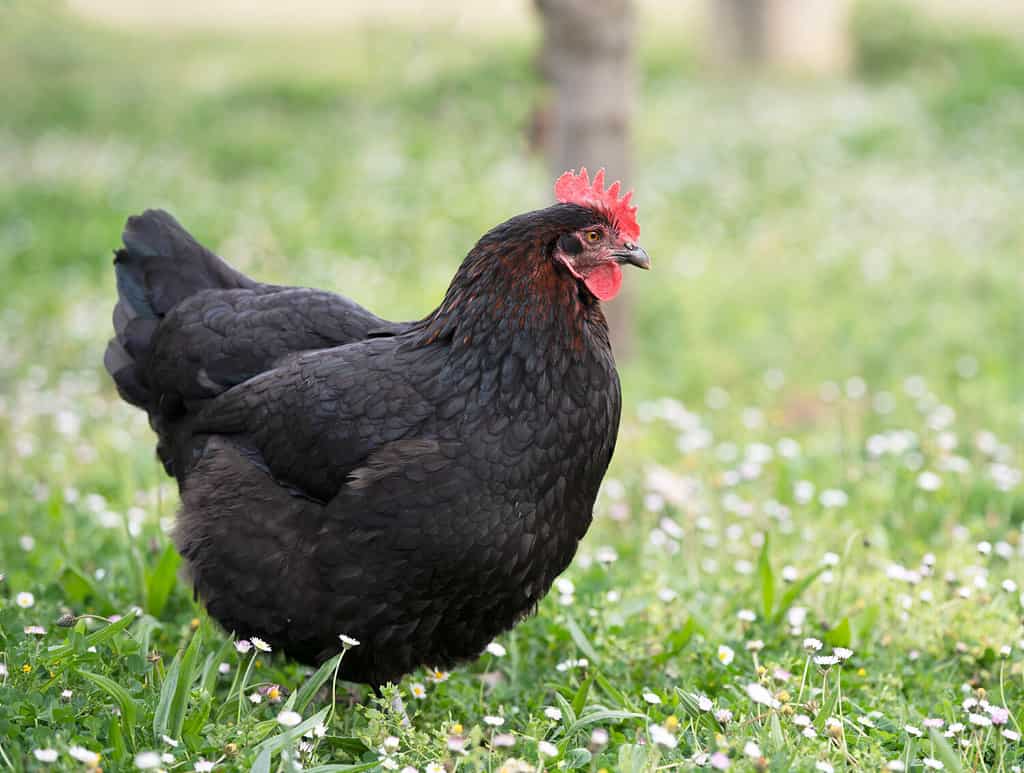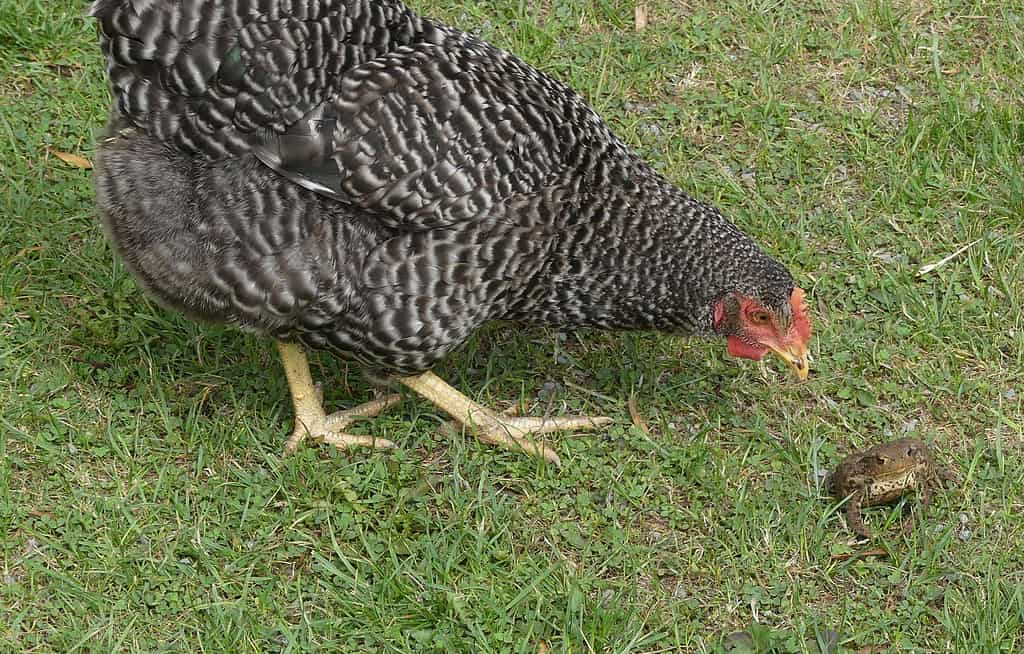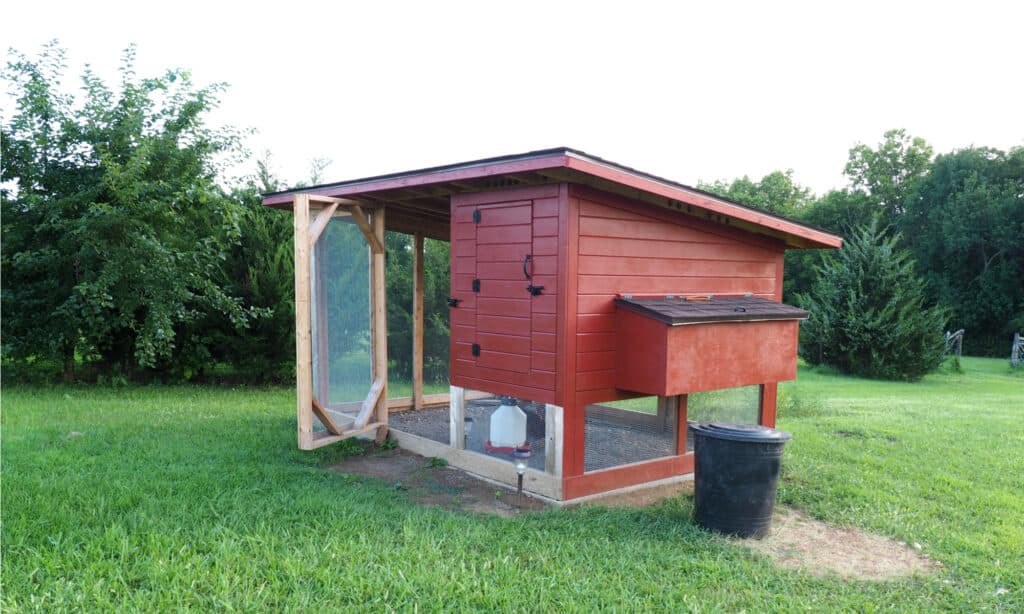Marans chickens (Gallus gallus domesticus) vary in price depending on their color, sex, and age. Marans are friendly chickens and they also lay highly valuable, dark brown (almost chocolate) colored eggs. There is a ton of variety in Marans chickens, so you can pay from as little as $9 for a Black Copper female chick up to $110 for a rare Blue Splash Maran under one year of age. The price you pay for a Marans chick is worth it if you sell eggs at farmer’s markets, breed chickens, or simply just enjoy fresh eggs from your own yard.
Marans Chickens: Appearance, Lifespan, and Egg Production

There are many different colors available for Marans chickens, such as the black copper variety in the photo.
©cynoclub/Shutterstock.com
The price of Marans chicken depends on the variety you purchase. Some are more common and others are rare, which will, of course, increase the value. They weigh about the same regardless of variety, which is around 7-8 pounds at a healthy weight.
The average lifespan of a Marans chicken is about 8 years. Females will start laying between 6-9 months of age and continue to lay regularly until 6 years of age. As the hen gets older, the frequency and amount of eggs laid will decrease. You can expect somewhere in the ballpark of 150-200 eggs per year from a Marans hen. That is around 3-4 eggs per week, per chicken. To get to this amount, you have to take good care of the hens and feed them the right diet along with reducing stress.
Prices and Varieties
While there are many different varieties of Marans chickens, only four are “recognized” by the American Poultry Association. The price will depend on the age, sex, and variety of Marans chicken. Here are some varieties available and their average price for female Marans chicks:
- Silver Cuckoo: $6
- Black Copper: $10
- Wheaten: $16
- Golden Cuckoo: $16
- Blue Cuckoo: $22
- Blue Copper: $23
- Splash varieties (blue, black): $16-28

Cuckoo Marans have a barred appearance.
©Stephen William Robinson/Shutterstock.com
Female chicks are more expensive than male chicks. “Teenage” chickens, under one year old, are more expensive than chicks. Females are called “pullets” and males “cockerels”. These chickens show more of their true coloration and are easier to sex. Therefore, a female pullet is likely to be the most expensive chicken However, you get the eggs in return. If you have multiple hens that are frequently laying eggs, you might need to pick them up twice a day, especially if you’re planning on eating the eggs. If you have a male for the hen to mate with, you can get baby chicks that can add to the numbers in your brood, or you can sell them yourself!
Buying a Healthy Chick
One of the most important parts when purchasing chicks is ensuring they are healthy. Some diseases are infectious among chickens. If you already have chickens, it’s doubly important to be sure the new ones you’re bringing in won’t spread any disease. Here are some tips on telling whether a chick is healthy:
- Healthy chicks have bright eyes and appear alert to their surroundings.
- They should look generally clean.
- A healthy chick will be somewhat fluffy and will not appear injured; injuries can look like holding one leg up or having a “droopy” appearance to their head and wings.
Some issues can be genetic, which are not contagious. Other issues can be a sign of poor nutrition. A low weight, gauntness, or incoordination can be signs of malnutrition in a chick and can be remedied with the right diet. Determining if the chick you’re about to buy is healthy is easier to do in person, though it might not be as easy to find people who have the specific variety available.
Infectious diseases most often stem from unclean environments. While a benefit of buying your chicks in person is looking at the facilities, it might not be easy to do without having to travel. Purchasing chicks online gives you access to a wider variety though you do not have access to the facilities. You might have some luck reaching out to the owner to get pictures of their facilities. Oftentimes, these websites will have guarantees for the delivery of healthy, live chicks. Purchasing from reputable sites gives you a higher chance that the quality and health of your chicken will meet your expectations.
Supplies

Chicken coops should have a combination of raised areas, closed sides and open sides, and a sturdy, weather-proof roof.
©Cynthia Farmer/Shutterstock.com
The size of the coop you will need will depend on how many chickens you’re housing. Ideally, there will be 20 cubic feet of space per Marans chicken. Larger coops with big nesting boxes and more “bells and whistles” will cost more but will likely lead to a happier chicken. In turn, happier chickens are more likely to produce eggs frequently.
Aside from the size of the coop, some nonnegotiables when selecting one is having a waterproof roof and a coop that is well protected against drafts. While many will allow their chickens to roam about a yard, having a safe spot for the chickens at night or in poor weather conditions is needed. A perching area is also necessary for the chickens to sleep upon. A well-constructed coop will also help deter predators from coming in to prey on your chickens and their eggs.
Food
Having the proper diet for your chicken is integral to their health, but also the quality of eggs they lay. Marans chickens are often raised not only for their eggs, but their meat. So, having a quality diet will go a long way for their overall health, longevity, egg-laying abilities, and taste. It is worth the price to feed your Marans chickens high-quality food and will surely guarantee a return on your investment!
Free-ranging
Marans like to free-range just as other chickens do. If this is possible for your set-up, consider allowing the chickens to do so. Marans chickens will eat a variety of forage, such as invertebrates, small reptiles, and leaf greens. Grit is an essential part of ensuring gizzard function. This can be in the form of small pebbles and can be purchased to sprinkle in your yard. It should be noted that free-ranging is good to help include variety in your chicken’s diet, but a quality premade feed is still bound to be the primary source of nutrition for your chicken.
Premade Feeds

Eggshell color variety is dependent on genetics, but diet can impact the color of the yolk.
©Mario Elias Munoz Valencia/ via Getty Images
A quality commercial feed will give your Marans chickens the correct ratios of nutrients needed to function their best. Growers mash or starter feed might be useful to feed your chickens when they’re young, as they have a higher percentage of protein (around 19%) to support their growth, though this is only applicable if you get the chickens under 6 weeks of age. Quality grower feed can range in price from $30-40 for a bag between 35-40 pounds. Each baby chicken should be fed around 1-2 ounces per day, meaning one Marans chick will go through a pound of food in roughly one to two weeks. This food can be their primary source of nutrition until 18 weeks.
Then, transition them to layer pellets or mash to help with egg production. Layer feed costs about the same as grower feed but your chickens will eat more per day, so you’re likely to go through bags quicker than before. Grower feed is often supplemented with calcium, but having a separate bowl of crushed-up oyster shells or eggshells can help ensure they’re getting enough of this vital nutrient.
Quantity
On average, a single adult chicken will eat between 5-7 ounces of food per day. Observe the quantity your chickens eat and adjust as needed to avoid food waste. Uneaten food can attract scavengers to your chickens. Mice or rats can spread diseases to your flock, and other scavenging animals like possums can attack your chickens. This is another reason why it’s important to have a well-sealed coop.
Water
Water is essential for all living animals, so your chickens should always have access to fresh, clean water. Ideally, the water should be fresh every day. In addition to changing the water regularly, weekly disinfection of their water bowls and their coop is a good idea to maintain a clean environment. You can keep the water in a dark area of the coop to help it stay cool, as this is the preference. The water should be slightly elevated so the chickens don’t dirty it by scratching up soil or dirt.
The photo featured at the top of this post is © cynoclub/Shutterstock.com
Thank you for reading! Have some feedback for us? Contact the AZ Animals editorial team.






